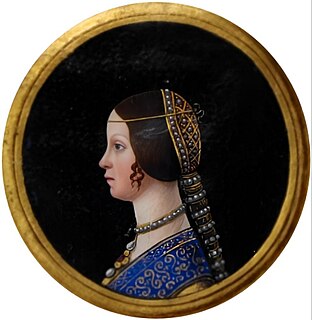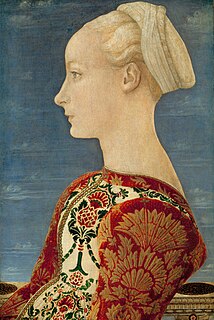
Francesco I Sforza was an Italian condottiero who founded the Sforza dynasty in the duchy of Milan, ruling as its (fourth) duke from 1450 until his death. He was the brother of Alessandro, whom he often fought alongside.

Isabella d'Este was Marchioness of Mantua and one of the leading women of the Italian Renaissance as a major cultural and political figure. She was a patron of the arts as well as a leader of fashion, whose innovative style of dressing was copied by numerous women. The poet Ariosto labeled her as the "liberal and magnanimous Isabella", while author Matteo Bandello described her as having been "supreme among women". Diplomat Niccolò da Correggio went even further by hailing her as "The First Lady of the world".

Sforza was a ruling family of Renaissance Italy, based in Milan. They acquired the Duchy of Milan following the extinction of the Visconti family in the mid-15th century, Sforza rule ending in Milan with the death of the last member of the family's main branch in 1535.

Ludovico III Gonzaga of Mantua, also spelled Lodovico was the ruler of the Italian city of Mantua from 1444 to his death in 1478.

Ludovico Maria Sforza, also known as Ludovico il Moro. "Arbiter of Italy", according to the expression used by Guicciardini, was an Italian Renaissance nobleman who ruled as Duke of Milan from 1494 to 1499. His ascendancy followed the death of his nephew Gian Galeazzo Sforza. A member of the Sforza family, he was the fourth son of Francesco I Sforza. A patron of the arts during the Milanese Renaissance, he commissioned the fresco of The Last Supper by Leonardo da Vinci. He also played a central role in the Italian Wars.

The Visconti of Milan are a noble Italian family. They rose to power in Milan during the Middle Ages where they ruled from 1277 to 1447, initially as lords then as dukes, and several collateral branches still exist. The effective founder of the Visconti lordship of Milan was the archbishop Ottone, who wrested control of the city from the rival Della Torre family in 1277.

Muzio Attendolo Sforza, was an Italian condottiero. Founder of the Sforza dynasty, he led a Bolognese-Florentine army at the Battle of Casalecchio.

Filippo Maria Visconti was duke of Milan from 1412 to 1447.

Sigismondo Pandolfo Malatesta was an Italian condottiero and nobleman, a member of the House of Malatesta and lord of Rimini and Fano from 1432. He was widely considered by his contemporaries as one of the most daring military leaders in Italy and commanded the Venetian forces in the 1465 campaign against the Ottoman Empire. He was also a poet and patron of the arts.

Virginia de' Medici was an Italian princess, a member of the House of Medici and by marriage Duchess of Modena and Reggio.

Beatrice d'Este, was Duchess of Bari and Milan by marriage to Ludovico Sforza. She was one of the most important personalities of the time and, despite her short life, she was a major player in Italian politics. A woman of culture, an important patron, a leader in fashion: alongside her illustrious husband she made Milan one of the greatest capitals of the European Renaissance. With her own determination and bellicose nature, she was the soul of the Milanese resistance against the enemy French during the first of the Italian Wars.

Bianca Maria Visconti was Duchess of Milan from 1450 to 1468 by marriage to Francesco I Sforza. She was regent of Marche during the absence of her spouse in 1448. She served as Regent of the Duchy of Milan during the illness of her spouse in 1462, as well as in 1466, between the death of her spouse and until her son, the new Duke, who was absent, was able to return to Milan to assume power.

Niccolò III d'Este was Marquess of Ferrara from 1393 until his death. He was also a condottiero.

Agnese del Maino was a Milanese noblewoman and the mistress of Filippo Maria Visconti, the last legitimate duke of Milan of the Visconti dynasty. Agnese was the mother of Duchess Bianca Maria Visconti.

Lucrezia Landriani was the mistress of Galeazzo Maria Sforza, Duke of Milan, and the mother of his renowned illegitimate daughter, Caterina Sforza, Lady of Imola, Countess of Forlì. Lucrezia had three other children by the Duke, and two by her husband.

Eleonora Gonzaga, Duchess of Urbino was Duchess and sometime regent of Urbino by marriage to Francesco Maria I della Rovere, duke of Urbino.

Galeazzo da Sanseverino, known as the son of Fortuna, was an Italian-French condottiere and Grand Écuyer de France; Marquis of Bobbio, Count of Caiazzo, Castel San Giovanni, Val Tidone and Voghera. He was first the favorite of Ludovico il Moro and Beatrice d'Este, then of Louis XII and Francis I of France, as well as a sworn enemy of Gian Giacomo Trivulzio.
On the other hand the Duke of Milan
called and gave the general cane
to Maria Galeazo, and captain
did it of his people on the saddle,
who riding then from hand to hand,
with the banner in the wind of the snake,
honor and glory of Lombardy,
with many great gentlemen in company.

Roberto Sanseverino d'Aragona was an Italian condottiero, count of Colorno from 1458 to 1477 and count of Caiazzo from 1460 until his death in 1487. Highly esteemed man of arms, veteran of numerous battles, he was one of the greatest leaders of the Italian Renaissance.

Sforza Secondo Sforza was an Italian condottiero.

Leonardo is a historical drama created by Frank Spotnitz and Steve Thompson. The series was produced by Italian Lux Vide in collaboration with Rai Fiction, Sony Pictures Entertainment, with Frank Spotnitz's Big Light Productions and Freddie Highmore's Alfresco Pictures in association with France Télévisions and RTVE.